
Central is the central business district of Hong Kong. It is located in the northeastern corner of the Central and Western District,on the north shore of Hong Kong Island,across Victoria Harbour from Tsim Sha Tsui,the southernmost point of Kowloon Peninsula. The area was the heart of Victoria City,although that name is rarely used today.
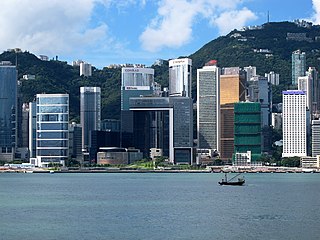
Admiralty is the eastern extension of the central business district on the Hong Kong Island of Hong Kong. It is located on the eastern end of the Central and Western District,bordered by Wan Chai to the east and Victoria Harbour to the north.

The Hong Kong Museum of Coastal Defence is a public museum in Hong Kong,located in a former coastal defence fort overlooking the Lei Yue Mun channel,near Shau Kei Wan on Hong Kong Island. The fort was built by the British in 1887,intended to defend the eastern approaches to Victoria Harbour.

The Battle of Hong Kong,also known as the Defence of Hong Kong and the Fall of Hong Kong,was one of the first battles of the Pacific War in World War II. On the same morning as the attack on Pearl Harbor,forces of the Empire of Japan attacked the British Crown colony of Hong Kong around the same time that Japan declared war on Great Britain. The Hong Kong garrison consisted of British,Indian and Canadian units,also the Auxiliary Defence Units and Hong Kong Volunteer Defence Corps (HKVDC).
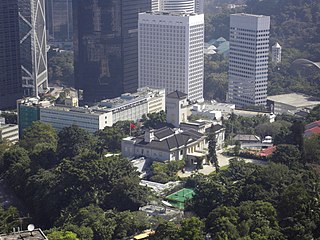
The Government Hill is a hill in Central,Hong Kong,bounded by upper section of Upper Albert Road on the south,Queen's Road Central north,Garden Road east,and Glenealy,west of Hong Kong Island.
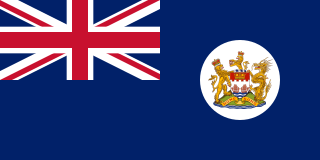
British Forces Overseas Hong Kong comprised the elements of the British Army,Royal Navy and Royal Air Force stationed in British Hong Kong. The Governor of Hong Kong also assumed the position of the commander-in-chief of the forces and the Commander British Forces in Hong Kong took charge of the daily deployment of the troops. Much of the British military left prior to the handover of Hong Kong to China in 1997. The present article focuses mainly on the British garrison in Hong Kong in the post Second World War era. For more information concerning the British garrison during the Second World War and earlier,see the Battle of Hong Kong.

The People's Liberation Army Hong Kong Garrison is a garrison of the People's Liberation Army (PLA),responsible for defence duties in the Hong Kong Special Administrative Region (SAR) since the handover of Hong Kong in 1997.

The Royal Hong Kong Regiment (The Volunteers) (RHKR(V)) (Chinese:皇家香港軍團(義勇軍),formed in May 1854,was a local auxiliary militia force funded and administered by the colonial Government of Hong Kong. Its powers and duties were mandated by the Royal Hong Kong Regiment Ordinance.
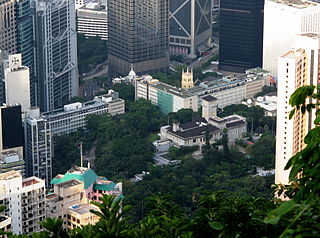
The Former Central Government Offices,now called Justice Place,is an office building complex that formerly housed most of the major offices of the Hong Kong Government. The complex is located in Central,Hong Kong,occupying the lower level of Government Hill. The offices of the government have been relocated to the Main Block of the Central Government Complex,Tamar.

Gun Club Hill Barracks are barracks in King's Park,or in Jordan,Hong Kong formerly used by British Army garrisons during British colonial rule. The military began using the area shortly after 1860 when the British acquired Kowloon. The barracks are bounded by Austin Road,Jordan Path,Gascoigne Road and Chatham Road South.

Wellington Street is a one-way street located in Central and Sheung Wan,Hong Kong. Named after Arthur Wellesley,1st Duke of Wellington,it stretches from Wyndham Street to Queen's Road Central. The two sides of street is a mosaic of old and new buildings. Varieties of trades can be found on the street level. Street markets can be found in the adjacent lanes.
Wellington Barracks was a military barracks located to the east of Garden Road in Admiralty,Hong Kong. One of many military complexes constructed by the British Army in the area,the land was returned to the Hong Kong government in the 1970s and gradually reverted to civilian use. As a result,the barracks was closed at the end of that decade,demolished in the mid-1980s and replaced with Harcourt Garden.

Murray Barracks was a barracks for the British Army garrisoned in Admiralty,Central in Hong Kong. It was named after Sir George Murray,the Master-General of the Ordnance at the time of construction.
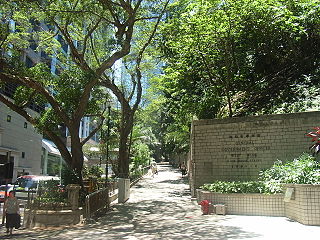
Battery Path is a pedestrian-only footpath located beneath Government Hill in Central,Hong Kong. Named after Murray Battery,it stretches from Queen's Road Central to Garden Road. The path is noted for many historical landmarks situated on it,most notably the Former Central Government Offices,the Former French Mission Building and St. John's Cathedral.
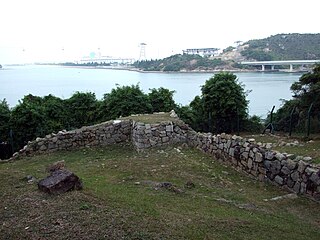
Tung Chung Battery is a former artillery battery located on Lantau Island in Hong Kong. Named after the eponymous district it is situated in,it was built in 1817,twenty-four years before the British took possession of Hong Kong. It was rediscovered in 1980 and is a declared monument of Hong Kong.

Beaconsfield House was a government office building in Hong Kong's Central district.
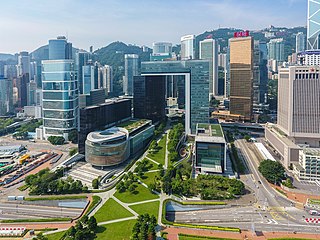
The Central Government Complex has been the headquarters of the Government of Hong Kong since 2011. Located at the Tamar site,the complex comprises the Central Government Offices,the Legislative Council Complex and the Office of the Chief Executive of Hong Kong. The complex has taken over the roles of several buildings,including the former Central Government Offices (CGO),Murray Building and the former Legislative Council Building.

Coastal defenceand coastal fortification are measures taken to provide protection against military attack at or near a coastline,for example,fortifications and coastal artillery. Because an invading enemy normally requires a port or harbour to sustain operations,such defences are usually concentrated around such facilities,or places where such facilities could be constructed. Coastal artillery fortifications generally followed the development of land fortifications,usually incorporating land defences;sometimes separate land defence forts were built to protect coastal forts. Through the middle 19th century,coastal forts could be bastion forts,star forts,polygonal forts,or sea forts,the first three types often with detached gun batteries called "water batteries". Coastal defence weapons throughout history were heavy naval guns or weapons based on them,often supplemented by lighter weapons. In the late 19th century separate batteries of coastal artillery replaced forts in some countries;in some areas these became widely separated geographically through the mid-20th century as weapon ranges increased. The amount of landward defence provided began to vary by country from the late 19th century;by 1900 new US forts almost totally neglected these defences. Booms were also usually part of a protected harbor's defences. In the middle 19th century underwater minefields and later controlled mines were often used,or stored in peacetime to be available in wartime. With the rise of the submarine threat at the beginning of the 20th century,anti-submarine nets were used extensively,usually added to boom defences,with major warships often being equipped with them through early World War I. In World War I railway artillery emerged and soon became part of coastal artillery in some countries;with railway artillery in coast defence some type of revolving mount had to be provided to allow tracking of fast-moving targets.
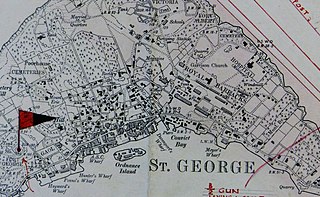
St. George's Garrison was the first permanent military camp of the Bermuda Garrison established in the British colony and Imperial fortress of Bermuda,with construction of Old Military Road and the original Royal Barracks commencing during the war between Britain and France that followed the French Revolution. It would remain in use until 1957,when it was transferred to the civil (colonial) government with most of the other Admiralty and War Office properties in Bermuda.

Lord Salisbury described Malta,Gibraltar,Bermuda,and Halifax as Imperial fortresses at the 1887 Colonial Conference,though by that point they had been so designated for decades. Later historians have also given the title "imperial fortress" to St. Helena and Mauritius.


















